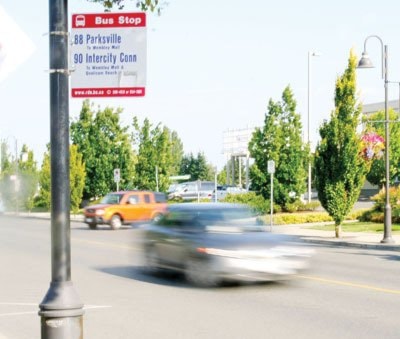A quick scan of local newspapers and online housing sites will show most affordable housing in Oceanside is found in the rural areas. But even if affordable housing is found in Parksville or Qualicum Beach, how easy is it for people to commute to work without paying for a vehicle and insurance?
Dawn Barry with the Parksville Residents Association (PRA) said transit within the Regional District of Nanaimo (RDN) is very unreliable.
“The schedules don’t seem to take into account that people from Parksville may wish to use public transit to get to and from a worksite in Nanaimo,” she said, adding the only group that seems to be acknowledged is those travelling to and from Vancouver Island University (VIU).
The PRA looked at public transportation as part of an overall transportation review and found some people were frustrated with the service, including Barry herself. She said it can take up to two hours to travel from Parksville to downtown Nanaimo, making public transport for work purposes impossible.
Anne Turner has been taking transit in Parksville since 1997 and commuting to VIU since 2002. She said service has improved, but in the afternoon it’s another story trying to get back to Parksville.
Beyond transit to Nanaimo, there is currently no transit service to Errington and Coombs, and nothing to the Qualicum Bay/Bowser/Deep Bay area.
Recently, a study was done in Area H (Qualicum Bay/Bowser/Deep Bay) by BC Transit and the RDN and it found seniors, youth and people with disabilities were the best potential markets.
A 2006 census found of the Area H residents that work outside the home, 83 per cent commute outside of the area. The report also stated the number of Area H individuals working in construction trades is more than double the provincial average, and those working in the service industry were also high. In general it is harder to attract workers in these industries to transit due to irregular shift times, the report concluded.
Also, Area H is considered a low-density community, with 12.5 persons per square kilometre — compared with 881.8 persons per square km for the City of Nanaimo. As a general guideline a gross density of 1,000 residents per square km is considered a minimum to support local transit service with a 60-minutre service frequency.
Area H director David Bartram said he members from the community made a presentation to the RDN’s transit select committee asking them to consider Paratransit (normally a smaller minibus) one day a week, twice a day, for people to make the connection to Qualicum Beach.
“Because of our population base, that would serve the immediate needs of those people that are most in need of transit,” he said. “Housing is affordable out here, so you make that connection so people can get into town. It doesn’t solve the problem of the worker going back and forth but right now we don’t have the population or the funds to be able to support that.”
RDN staff is working on the transit recommendations. If approved at the local level, funding would then also have to be approved by BC Transit.
Daniel Pearce, Manager of Transit and Planning with the RDN said it is easier to get transit in areas with high density because it will be more cost efficient, but it really comes down to the needs of the community.
Affordable housing is available in some areas of Nanoose Bay and transit currently operates regularly along Northwest Bay Road. Although Area E (Nanoose Bay) director George Holme has had requests from mostly retired people to expand the service to Fairwinds, Schooner Cove, as well as the Beachcomber and Madrona areas, he has not heard complaints from people in the work force trying to get to work. He has asked for a transit study but said it’s dependant upon money from BC Transit.
Pearce added transit feasibility studies are planned for Coombs and Errington in the next couple of years.
Another option for people to get from rural areas to their place of work or to amenities is car pooling. Isabelle Boulard is a co-founder of Carpoolworld.com, a website that provides a free public on-line trip-matching service. Users can enter their starting point and destinations and a list of matches in the given area may come up.
Although the site is far more popular in big cities, it does still work in small communities, Boulard said.
“In small towns we often find that people know each other and will find their own peers to carpool with, (but) we still do have some small town residents using our service,” she said in an e-mail.
Jack Bell Ride-Share is another online ride matching website that also offers public vanpooling. It is a charitable B.C. Society funded by TransLink and BC Transit.
The site claims that anyone with a clean driving record can operate the organization’s vehicles and pay a monthly fee to drive themselves and others in the area to and from work.
Although transit in the Oceanside area is not feasible for those travelling to work it seems to be improving for retired groups out of the workforce, looking to get into Qualicum Beach, Parksville and connecting to Nanaimo. Those who have found affordable housing in the rural areas may be struggling with the cost of getting to work, but carpooling may provide a viable option, whether it’s through an online site or with friends.
Other commuting options could involve riding a bike to work, if feasible, or as an alternative to a car, purchasing a motorized scooter, which could save on gas and insurance.
reporter@pqbnews.com
